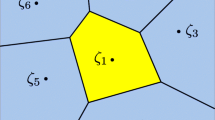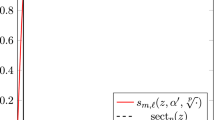Abstract
Schröder’s iterative formula of the second kind (S2 formula) for finding zeros of a function f(z) is a generalization of Newton’s formula to an arbitrary order m of convergence. For iterative formulae, convergence regions of initial values to zeros in the complex plane z are essential. From numerical experiments, it is suggested that as order m of the S2 formula grows, the complicated fractal structure of the boundary of convergence regions gradually diminishes. We propose a method of estimating the convergence regions with the circles of Apollonius to verify this result for polynomials f(z) with simple zeros. We indeed show that as m grows, each region surrounded by the circles of Apollonius monotonically enlarges to the Voronoi cell of a zero of f(z). Numerical examples illustrate convergence regions for several values of m and some polynomials.
Similar content being viewed by others
References
Amat, S., Busquier, S., Plaza, S.: Review of some iterative root–finding methods from a dynamical point of view. Scientia 10, 3–35 (2004)
Aurenhammer, F.: Voronoi diagrams – a survey of a fundamental geometric data structure. ACM Comput. Surv. 23, 345–405 (1991)
Blanchard, P.: Complex analytic dynamics on the Riemann sphere. Bull. Amer. Math. Soc. (N.S.) 11, 85–141 (1984)
Buff, X., Henriksen, C.: On König’s root-finding algorithms. Nonlinearity 16, 989–1015 (2003)
Drakopoulos, V., Argyropoulos, N., Böhm, A.: Generalized computation of Schröder iteration functions to motivate families of Julia and Mandelbrot-like sets. SIAM J. Numer. Anal. 36, 417–435 (1999)
Gautschi, W.: Numerical Analysis: an Introduction. Birkhäuser, Boston (1997)
Higham, N.J.: Accuracy and Stability of Numerical Algorithms, 2nd edn. SIAM, Philadelphia (2002)
Honorato, G.: On the Julia set of König’s root-finding algorithms. Proc. Amer. Math. Soc. 141, 3601–3607 (2013)
Honorato, G.: Dynamics and limiting behavior of Julia set of König’s method for multiple roots. Topology Appl. 233, 16–32 (2018)
Householder, A.S.: Principle of Numerical Analysis. McGraw-Hill, New York (1953)
Kalantari, B.: Polynomiography and applications in art, education, and science. Comput. Graph. 28, 417–430 (2004)
Kalantari, B.: Polynomial Root-finding and Polynomiography. World Scientific, New Jersey (2008)
Kalantari, B.: Polynomial root-finding methods whose basins of attraction approximate Voronoi diagram. Discrete Comput. Geom. 46, 187–203 (2011)
Kalantari, B., Jin, Y.: On extraneous fixed-points of the basic family of iteration functions. BIT Numer. Math. 43, 453–458 (2003)
Kalantari, B., Kalantari, I., Zaare-Nahandi, R.: A basic family of iteration functions for polynomial root finding and its characterizations. J. Comput. Appl. Math. 80, 209–226 (1997)
Overton, M.L.: Numerical Computing with IEEE Floating Point Arithmetic. SIAM, Philadelphia (2001)
Petković, M.S., Petković, L.D.: Dynamic study of Schröder’s families of first and second kind. Numer. Algorithms 78, 847–865 (2018)
Petković, M.S., Petković, L.D., Herceg, D.: On Schröder’s families on root-finding methods. J. Comput. Appl. Math. 233, 1755–1762 (2010)
Pomentale, T.: A class of iterative method for holomorphic function. Numer. Math. 18, 193–203 (1971)
Schröder, E.: Ueber unendlich viele Algorithmen zur Auflösung der Gleichungen. Math. Ann. 2, 317–365 (1870)
Schröder, E.: On Infinitely Many Algorithms for Solving Equations, Translated by G. W. Stewart. Tech. Rep., TR-92-121, Institute for Advanced Computer Studies, University of Maryland, College Park, MD (1992)
Vrscay, E.R., Gilbert, W.J.: Extraneous fixed point, basin boundaries and chaotic dynamics for Schröder and König rational iteration functions. Numer. Math. 52, 1–16 (1988)
Acknowledgments
We thank one of the referees for his valuable comments for improving the presentation of the manuscript. Further, we thank him for suggesting useful references including [12], a book that contains many impressive figures of convergence regions.
Author information
Authors and Affiliations
Corresponding author
Appendix: Proof of Lemma 4.2
Appendix: Proof of Lemma 4.2
From (4.4) we have
In view of x ∈ (0,1) and t > 0, from (A.1) we have log(x/B) < 0. It follows that
Since from (A.1) we have
τ(x) monotonically decreases on (0,B1). Therefore, t = τ(x) has the inverse function x = ψ(t) (0 < t < ∞) that monotonically decreases and \(\lim _{t\to \infty }\psi (t)= 0\).
It remains to verify (4.5). Expanding log(1 − x) in (A.1) gives
Substituting x = (log t)/t in (A.2), we have
So, for log t ≥ B, or t ≥ eB, we have τ((log t)/t) < t. Recalling that x = ψ(t) is a monotonically decreasing function, we obtain
This establishes the lemma.
Rights and permissions
About this article
Cite this article
Suzuki, T., Sugiura, H. & Hasegawa, T. Estimating convergence regions of Schröder’s iteration formula: how the Julia set shrinks to the Voronoi boundary. Numer Algor 82, 183–199 (2019). https://doi.org/10.1007/s11075-018-0598-8
Received:
Accepted:
Published:
Issue Date:
DOI: https://doi.org/10.1007/s11075-018-0598-8
Keywords
- Root finding
- Schröder’s method
- Basin of attraction
- Algebraic equation
- Voronoi diagram
- Circles of Apollonius




